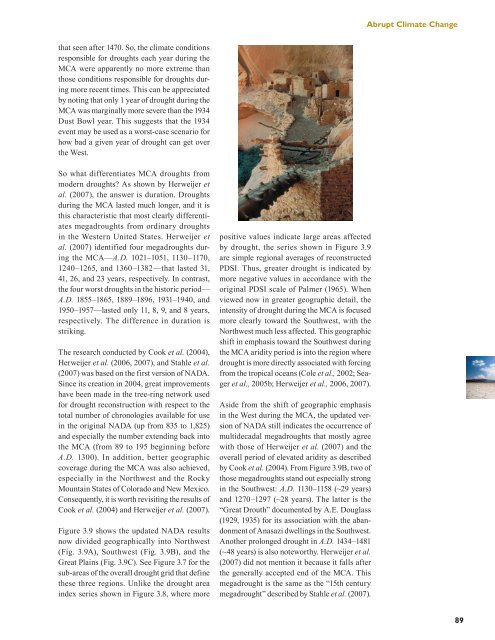Book 2.indb - US Climate Change Science Program
Book 2.indb - US Climate Change Science Program
Book 2.indb - US Climate Change Science Program
- No tags were found...
Create successful ePaper yourself
Turn your PDF publications into a flip-book with our unique Google optimized e-Paper software.
Abrupt <strong>Climate</strong> <strong>Change</strong>that seen after 1470. So, the climate conditionsresponsible for droughts each year during theMCA were apparently no more extreme thanthose conditions responsible for droughts duringmore recent times. This can be appreciatedby noting that only 1 year of drought during theMCA was marginally more severe than the 1934Dust Bowl year. This suggests that the 1934event may be used as a worst-case scenario forhow bad a given year of drought can get overthe West.So what differentiates MCA droughts frommodern droughts? As shown by Herweijer etal. (2007), the answer is duration. Droughtsduring the MCA lasted much longer, and it isthis characteristic that most clearly differentiatesmegadroughts from ordinary droughtsin the Western United States. Herweijer etal. (2007) identified four megadroughts duringthe MCA—A.D. 1021–1051, 1130–1170,1240–1265, and 1360–1382—that lasted 31,41, 26, and 23 years, respectively. In contrast,the four worst droughts in the historic period—A.D. 1855–1865, 1889–1896, 1931–1940, and1950–1957—lasted only 11, 8, 9, and 8 years,respectively. The difference in duration isstriking.The research conducted by Cook et al. (2004),Herweijer et al. (2006, 2007), and Stahle et al.(2007) was based on the first version of NADA.Since its creation in 2004, great improvementshave been made in the tree-ring network usedfor drought reconstruction with respect to thetotal number of chronologies available for usein the original NADA (up from 835 to 1,825)and especially the number extending back intothe MCA (from 89 to 195 beginning beforeA.D. 1300). In addition, better geographiccoverage during the MCA was also achieved,especially in the Northwest and the RockyMountain States of Colorado and New Mexico.Consequently, it is worth revisiting the results ofCook et al. (2004) and Herweijer et al. (2007).Figure 3.9 shows the updated NADA resultsnow divided geographically into Northwest(Fig. 3.9A), Southwest (Fig. 3.9B), and theGreat Plains (Fig. 3.9C). See Figure 3.7 for thesub-areas of the overall drought grid that definethese three regions. Unlike the drought areaindex series shown in Figure 3.8, where morepositive values indicate large areas affectedby drought, the series shown in Figure 3.9are simple regional averages of reconstructedPDSI. Thus, greater drought is indicated bymore negative values in accordance with theoriginal PDSI scale of Palmer (1965). Whenviewed now in greater geographic detail, theintensity of drought during the MCA is focusedmore clearly toward the Southwest, with theNorthwest much less affected. This geographicshift in emphasis toward the Southwest duringthe MCA aridity period is into the region wheredrought is more directly associated with forcingfrom the tropical oceans (Cole et al., 2002; Seageret al., 2005b; Herweijer et al., 2006, 2007).Aside from the shift of geographic emphasisin the West during the MCA, the updated versionof NADA still indicates the occurrence ofmultidecadal megadroughts that mostly agreewith those of Herweijer et al. (2007) and theoverall period of elevated aridity as describedby Cook et al. (2004). From Figure 3.9B, two ofthose megadroughts stand out especially strongin the Southwest: A.D. 1130–1158 (~29 years)and 1270–1297 (~28 years). The latter is the“Great Drouth” documented by A.E. Douglass(1929, 1935) for its association with the abandonmentof Anasazi dwellings in the Southwest.Another prolonged drought in A.D. 1434–1481(~48 years) is also noteworthy. Herweijer et al.(2007) did not mention it because it falls afterthe generally accepted end of the MCA. Thismegadrought is the same as the “15th centurymegadrought” described by Stahle et al. (2007).89






